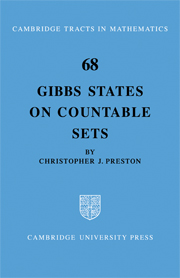Book contents
- Frontmatter
- Contents
- Preface
- 1 Gibbs states and Markov random fields
- 2 Interacting particle systems
- 3 Coupled Markov chains
- 4 Gibbs states and Markov random fields on countable graphs
- 5 Gibbs states on countable sets
- 6 Kirkwood–Salsburg equations
- 7 Involutions of P(S)
- 8 Attractive and supermodular potentials
- 9 Attractive pair potentials
- 10 Examples of phase transition
- 11 11 The extreme points of GV
- Appendix The Lee-Yang circle theorem revisited
- Bibliography
- Index
5 - Gibbs states on countable sets
Published online by Cambridge University Press: 07 October 2011
- Frontmatter
- Contents
- Preface
- 1 Gibbs states and Markov random fields
- 2 Interacting particle systems
- 3 Coupled Markov chains
- 4 Gibbs states and Markov random fields on countable graphs
- 5 Gibbs states on countable sets
- 6 Kirkwood–Salsburg equations
- 7 Involutions of P(S)
- 8 Attractive and supermodular potentials
- 9 Attractive pair potentials
- 10 Examples of phase transition
- 11 11 The extreme points of GV
- Appendix The Lee-Yang circle theorem revisited
- Bibliography
- Index
Summary
In this chapter we will examine certain probability measures on P(S), the set of all subsets of S, where S is a countable set. We will be interested in the existence and uniqueness of measures satisfying certain properties. As before we will regard the points of S as sites, each of which can be either empty or occupied by a particle (or some other entity); the subset A ∈ P(S) will be regarded as describing the situation when the points of A are occupied and the points of S - A are empty. The elements of P(S) will sometimes be called configurations and the probability measures on P(S) that we will look at will describe the equilibrium distribution of the configurations of some model.
The basic assumption concerning the models that we will consider is the following: let ∧ be a finite subset of S, A ⊂ ∧ and X ⊂ S - ∧; we will suppose that the model is such that the conditional probability of there being particles on ∧ at exactly the points of A, given that on S - ∧ there are particles at exactly the points of X, is specified. (This says that if we know what is happening outside a finite subset of S then we can compute the distribution of particles inside the finite set.) Let us denote the above conditional probability hy f∧(A,X); our aim in this chapter is firstly to determine what relations the f∧(A,X) must satisfy and secondly, to find out whether the f∧(A,X) uniquely determine a probability measure on P(S).
- Type
- Chapter
- Information
- Gibbs States on Countable Sets , pp. 33 - 45Publisher: Cambridge University PressPrint publication year: 1974



